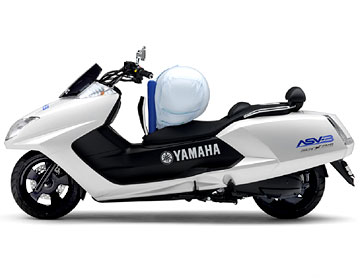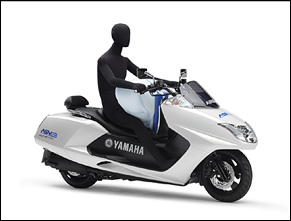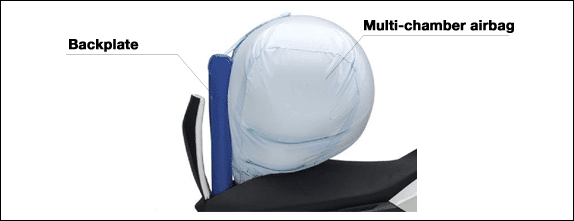Yamaha Motor Co., Ltd. (the “Company”)
will exhibit the Yamaha ASV-3 research vehicle -- incorporating a new
airbag system being developed for motorcycles -- at the 2006 JSAE Automotive
Engineering
Exposition. The Expo, sponsored by Society of Automotive Engineers of
Japan, Inc. will run from May 24 through 26 at the Pacifico Yokohama Exhibition
Hall.
The Yamaha ASV-3 is based on the technologies developed for its predecessor,
the Yamaha ASV-2, an Intelligent Transport Systems (ITS)-compatible,
research-use
vehicle with an airbag system, announced in 2000. However, the Yamaha
ASV-3 features a new, more advanced airbag system for improved crash
safety, being
developed using a variety of analysis software programs.
The Yamaha MAXAM
250cc scooter is the base vehicle for the ASV-3 to be exhibited in the 2006
JSAE Automotive Engineering Exposition. It incorporates a new “backplate
and multi-chamber” airbag system designed to simultaneously hold the
lumbar section of the rider in place and mitigate the impact of a collision.
|
 |
Yamaha ASV-3 research
vehicle incorporating an airbag system |
Name: |
Yamaha ASV-3 |
Display site: |
Yamaha booth in the 2006 Automotive Engineering Exposition |
Display period: |
May 24 through 26, 2006 |
* |
ASV is the Japanese Ministry of Land, Infrastructure
and Transport designation for its Advanced Safety Vehicle project,
promoting development of vehicles with improved safety by the 14 participating
vehicle
makers in Japan.
|
1) Development background
Airbags are commonly used in conjunction with seatbelts as a key safety device
in four-wheel vehicles, protecting occupants in collisions. For two-wheel
vehicles, however, the rider is not held in place by seatbelts, so a special
system had to be developed to offer effective protection in a collision.
The Company took the unique characteristics of motorcycles into consideration
in its research and development approach for two-wheel vehicle airbag systems.
The airbags should not only protect the rider in collision,
but also minimize secondary damage resulting from the rider being thrown from
the motorcycle.
|
 |
2) Development of the airbag for the Yamaha
ASV-3
In developing the motorcycle airbag, the Company creates collision analysis
models by combining the finite element method* with multi-body dynamics software,
and uses the models to analyze the rider injury in a crash. The Company also
uses collision analysis software based on the finite element method to analyze
the airbag deployment and other actions. In addition, the Company conducts
crash tests to verify the effectiveness of the motorcycle airbag system.
|
 |
3) Features of the Yamaha ASV-3 airbag
The airbag system incorporated in the Yamaha ASV-3 has an airbag located
closer to the rider and a backplate to hold the deployed airbag, in order
to hold the rider’s lumbar section in place and mitigate the impact
of a collision.
* The finite element method is a numerical calculation technique
widely used for structural analyses.
|

Deployed airbag of Yamaha ASV-3
|
|

Crash test
|
|
|

Deployed backplate and multi-chamber airbag
|
|